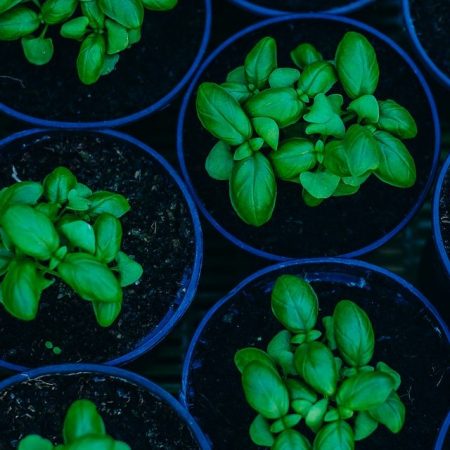If you want your herbs to grow into their most luscious, abundant self, then you need to know how to prune them. Pruning herbs or cutting off leaves and parts of stems helps them grow well. Left unpruned, your plant will grow and blossom but also starts to die. Regular pruning also alerts you to disease and insect problems that may start small and you could possibly remove before they affect the entire herb.
Why Prune Your Herbs?
Pruning is good for your plants. Firstly, it encourages fresh growth, which often helps a tall, thin plant develop bushier foliage. Furthermore, you prune to propagate new, rooted growth (more plants!) and to control the size of the plant itself. Also, regardless of what type of herb, whenever they start to blossom, you should remove them to redirect the growth energy back to the leaves and roots. The blossoms use up a lot of the plant’s energy, slowing the plant’s growth.
You can either light prune or hard prune. However, you shouldn’t over-prune. The goal is to help your plant thrive and grow, not impair it’s ability to produce new growth.
Light Prunning
Light pruning applies more generally to herbaceous plants such as basil, stevia, cilantro, etc., plants that thrive in summer. You have to continuously monitor growth in herbaceous plants because frequent trimming encourages the plants to sprout new growth, and continue to grow bushier and more productive. The process of “tipping” refers to cutting off the top few new growths to encourage the branch to grow outwards in two directions at the break.
When you don’t prune herbaceous plants, they either get large and begin to suffocate neighboring plants in the same shared bed, or their growth slows tremendously too early in the season, reducing the amount of leafy growth for you to harvest.

Hard Prunning
Hard pruning refers to evergreen or heartier perennial herbs like rosemary, lavender, thyme and sage that without much maintenance, are still capable of becoming robust garden perennials. You’ll need strong clippers to prune these.
You might also like: How to make cheese – For beginners
How Often Should You Prune Your Herbs?
It’s important be wary of removing too much plant. Big leaves, or leaves at the base of the plant are really important for the health of the plant because they absorb so much more sunlight than smaller leaves with new growth. Ensure you keep those leaves in tact for the overall health of the plant. That said, you’re often safe to prune back half of a healthy plant without reducing it’s ability to rebound.
You should only prune herbs in the evergreen family occasionally; no more than once or twice a year. The act of pruning encourages new growth, so it’s important to avoid pruning near the end of the growing season because at that time it’s important for them to be “toughening up” and not developing tender growth. Also avoid pruning during the cold season when the plant is in dormancy. For best results, cut your herbs back early in the year when new growth is beginning to show.
For both herbaceous and evergreen plants, it’s important not to trim back too much growth at a single time, but you do want to remove any dead branches that get in the way of new growth. A good rule of thumb is to cut dead branches back to the soil, but avoid cutting more than 1/3 or 1/4 from the overall healthy plant branch. Trimming a large herb back too quickly will thwart it’s ability to rebound.
Lavender is an exception: You’ll need to trim it way back towards the end of the rainy season, so that only 3-4” of green remains atop the wooded stem. Avoid cutting off all new growth, leaving only wood stems, as the plant may not be able to regenerate. A similar pruning in the early spring will help spur new growth. (Click here to read about growing lavender)
What Should You Do With Herb Trimmings?
As you practice light pruning, take advantage of your herbs and use them in fresh recipes. You can also dry herb trimmings to use all year long. If you’re growing commercially, you could start selling just from the beginning of the growing season.
What’s great about herbs is that many of the trimmings will easily reroot with a little effort, giving you more plants! Al you have to do is place your clean-cut herb trimmings into a jar with a little bit of water, and allow them to soak up sunlight from a window. Rotate the water every few days. After a few weeks, fresh roots will emerge from the herbs, and you can transplant the trimming back into the soil.

Herbs are growing so well and easy in Zambia. It might be a great product to grow, dry, or preserve for export.